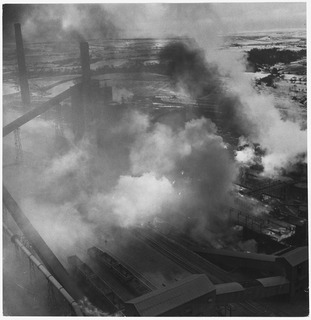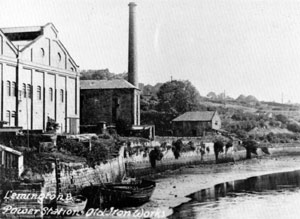
Consett is a town in County Durham, England, about 14 miles (23 km) south-west of Newcastle upon Tyne. It had a population of 27,394 in 2001 and an estimate of 25,812 in 2019.

Waskerley is a village in County Durham, England. It is situated six miles to the southwest of Consett and three miles southwest of Castleside and the A68. Stanhope in the Durham Dales is a further six miles to the southwest and the Derwent Reservoir and the village of Edmundbyers is approximately five miles to the north. The village of Muggleswick is three miles to the north.

Hartlepool nuclear power station is a nuclear power station situated on the northern bank of the mouth of the River Tees, 2.5 mi south of Hartlepool in County Durham, North East England. The station has a net electrical output of 1,190 megawatts, which is 2% of Great Britain's peak electricity demand of 60 GW. Electricity is produced through the use of two advanced gas-cooled reactors (AGR). Hartlepool was only the third nuclear power station in the United Kingdom to use AGR technology. It was also the first nuclear power station to be built close to a major urban area.
The Lancashire Electric Power Company was one of the largest private electricity companies in the UK. It was established in 1900 and generated and supplied electricity to 1,200 squares miles of Lancashire from 1905 until its abolition under nationalisation in 1948.

Dunston Power Station refers to a pair of adjacent coal-fired power stations in the North East of England, now demolished. They were built on the south bank of the River Tyne, in the western outskirts of Dunston in Gateshead. The two stations were built on a site which is now occupied by the MetroCentre. The first power station built on the site was known as Dunston A Power Station, and the second, which gradually replaced it between 1933 and 1950, was known as Dunston B Power Station. The A Station was, in its time, one of the largest in the country, and as well as burning coal had early open cycle gas turbine units. The B Station was the first of a new power station design, and stood as a landmark in the Tyne for over 50 years. From the A Station's opening in 1910 until the B Station's demolition in 1986, they collectively operated from the early days of electricity generation in the United Kingdom, through the industry's nationalisation, and until a decade before its privatisation.

The Consett Iron Company Ltd was an industrial business based in the Consett area of County Durham in the United Kingdom. The company owned coal mines and limestone quarries, and manufactured iron and steel. It was registered on 4 April 1864 as successor to the Derwent & Consett Iron Company Ltd. This in turn was the successor to the Derwent Iron Company, founded in 1840.

Lemington Power Station was a small, now demolished coal-fired power station, located in North East England. It was situated on the Lemington Gut, a backwater of the River Tyne, at Lemington, 3.5 mi (5.6 km) west of Newcastle upon Tyne. The station's main building stood until 2017 as a rare example of an early power station, dating from before the nationalisation of the United Kingdom's electrical supply industry.

Carville Power Station refers to a pair of now partially demolished coal-fired power stations, situated in North East England on the north bank of the River Tyne at Wallsend. The two stations were built alongside each other on a riverside site about 5 mi (8.0 km) downstream of Newcastle upon Tyne. Carville A Power Station, the first station on the site was opened in 1904, and Carville B Power Station was opened in 1916 to its south.
Neptune Bank Power Station was a coal-fired power station situated on the River Tyne at Wallsend near Newcastle upon Tyne. Commissioned in 1901 by the Newcastle upon Tyne Electric Supply Company, the station was the first in the world to provide electricity for purposes other than domestic and street lighting. It was also the first in the world to generate electricity using three-phase electrical power distribution at a voltage of 5,500 volts.
Blackburn Meadows power station is a biomass power station situated at Blackburn Meadows on the River Don, between Sheffield and Rotherham in South Yorkshire, England. Operated by E.ON UK, it was opened in 2014 and has an operating capacity of 30 megawatts.
Ottovale coke works was a large industrial complex situated at Blaydon Burn, near Blaydon-on-Tyne, Gateshead, North East England. The complex comprised a coke works, tar works and a power station. Built on the site of Dockendale Hall in 1904, it was operated by the Priestman Collieries until the 1970s.
Horden Colliery was a coal mine situated in Horden, near Peterlee in County Durham.

Philadelphia Power Station is a defunct coal-fired power station situated between the villages of Philadelphia and Newbottle, 1.5 mi (2.4 km) north of Houghton-le-Spring in Tyne and Wear, North East England.

Darlington power station refers to a series of two coal-fired power stations situated in Darlington in County Durham, North East England.

Whinfield coke works was a large industrial complex located near Rowlands Gill in Tyne and Wear, North East England. The complex comprised a coking plant, alloy factory and power station. Waste heat from the plant provided heat for a power station. This was later converted to generate electricity by burning coke.
Meaford Power Station was a coal-fired power station situated on the River Trent at Meaford near Stone in Staffordshire.

Padiham Power Station was a coal-fired power station in Padiham, east Lancashire, England, which began operation in 1926 and generated power from 1927 until it was closed in 1993.
Chopwell Colliery was a coal mine situated at Chopwell, in Gateshead, Tyne and Wear. The pit was first sunk in 1781, and was closed on 25 November 1966. The colliery was bought by the Consett Iron Company in 1896, before being handed over to the National Coal Board in 1947, when the British coal industry was nationalised. The colliery's highest employment numbers were in 1921, when 2,185 people worked there.
Newburn Steelworks was a large steel mill on the banks of the River Tyne at Newburn, near Newcastle upon Tyne, North East England.
The Percival Lane power station in Runcorn was built and operated by the Mersey Power Company Limited. It comprised two stations A and B commissioned in 1921 and 1941. The station supplied electricity to commercial, industrial and domestic users over a wide area of 95 square miles around the River Mersey including Widnes, Ellesmere Port and Runcorn.












